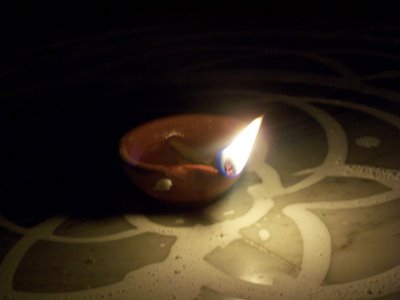These floor-decorations are a form of Indian folk art and is usually done by the women folk of the house. The motifs are uaually natural or geometric motifs. These floor decorations not only enhance the beauty of the surroundings, it also brings about warmth and hospitality.
This link aptly describes the following about 'Rangoli' and is also true for any other form of floor decoration commonly used in India:-
"Rangoli is a traditional Indian art created to decorate the ground in front of houses and places of worship to attract Lakshmi, the Hindu Goddess of wealth. Designs are created using decorative patterns marked out on the floor. The drawing of Rangoli patterns is often combined with rituals associated with auspicious occasions, such as major festivals and celebrations. The patterns are usually drawn by the women of the household in villages in parts of India; and in some places it is a daily ritual to mop and clean the entrance to the home and then make beautiful drawings in the doorways as a message of welcome."
It also tells about the different names for different types of floor decoration in India:
"There are different names for this craft depending on what part of India it comes from. There are Alpana from West Bengal, Aripan from Bihar and Orissa, Sathiya from Gujarat, Mandana from Raysatham, Kolam from Tamil Nadu and Rangoli from Maharastra."
 Diya lit over the 'Aripan' and 'Rangoli' at the entrance of my house on 'Diwali' - Photo by me
Diya lit over the 'Aripan' and 'Rangoli' at the entrance of my house on 'Diwali' - Photo by me  'Diya' lit over an 'Aripan' at the entrance of my house on 'Diwali' - Photo by Rashmiman
'Diya' lit over an 'Aripan' at the entrance of my house on 'Diwali' - Photo by Rashmiman
I have seen my grandmother make beautiful 'Aripan' on the floor during different occasions, festivals, marriage ceremonies, etc. and I have always been fascinated by the free-hand flow while drawing. 'Aripan' is made using rice paste. Rice is soaked overnight, ground into a paste and then with the right amount of water added to it to make the right consistency, the 'Aripan' is drawn, prominently with the 'ring-finger'. My 'Aripan' is nowhere close to what my grandmother used to draw, or still draws. Nonetheless, I do try my hand at it off and on. I make sure to draw even a small motif on Diwali ... and honestly, I enjoy doing that. This time, I also tried a small motif with 'Rangoli' and the pictures here are of those at the entrance of my house.

No comments:
Post a Comment